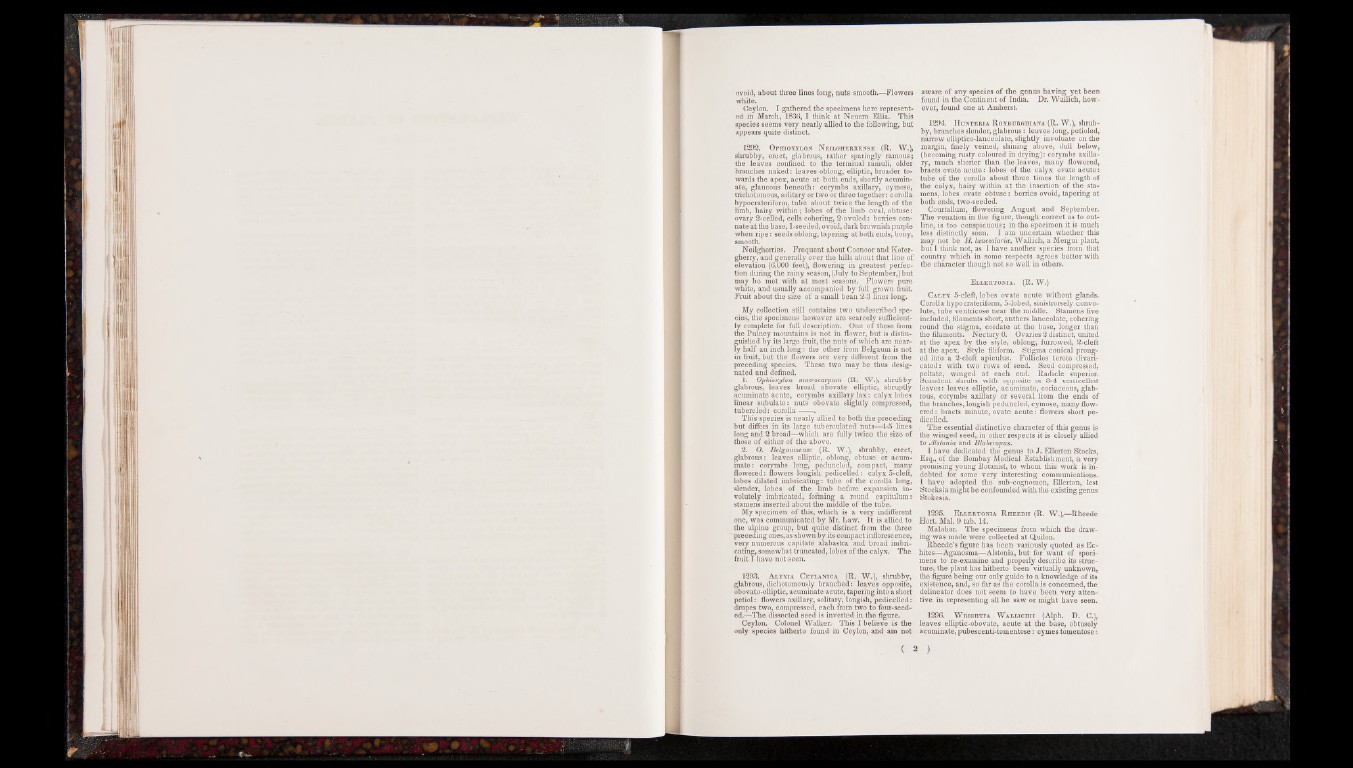
ovoid, about three lines long, nuts smooth.—Flowers
white.
Ceylon. I gathered the specimens here represented
in March, 1836, I think at Neuera Ellia. This
species seems very nearly allied to the following, but
appears quite distinct.
1292. Ophioxylon Neilgherrense (R. W.),
shrubby, erect, glabrous, rather sparingly ramous;
the leaves confined to the terminal ramuli, older
branches naked: leaves oblong, elliptic, broader towards
the apex, acute at both ends, shortly acumin- .
ate, glaucous beneath: corymbs axillary, cymose,
trichotomous, solitary or two or three together: corolla
hypocrateriform, tube about twice the length of the
limb, hairy within; lobes of the limb oval, obtuse:
ovary 2-celled, cells cohering, 2-ovuled: berries connate
at the base, 1-seeded, ovoid, dark brownish purple
when ripe: seeds oblong, tapering at both ends, bony,
smooth.
Neilgherries. Frequent about Coonoor and Koter-
gherry, and generally over the hills about that line of
elevation (6,000 feet), flowering in greatest perfection
during the rainy season, (July to September,) but
may be met with at most seasons. Flowers pure
white, and usually accompanied by full grown fruit.
Fruit about the size of a small bean 2-3 lines long.
My collection still contains two undescribed species,
the specimens however are scarcely sufficiently
complete for full description. One of these from
the Pulney mountains is not in flower, but is distinguished
by its large fruit, the nuts of which are nearly
half an inch long: the other from Belgaum is not
in fruit, but the flowers are very different from the
preceding species. These two may be thus designated
and defined.
1. Ophioxylon macrocarpum (R. W.), shrubby
glabrous, leaves broad obovate elliptic, abruptly
acuminate acute, corymbs axillary lax: calyx lobes
linear subulate: nuts obovate slightly compressed,
tubercled: corolla------ .
This species is nearly allied to both the preceding
but differs in its large tuberculated nuts—4-5 lines
long and 2 broad—which are fully twice the size of
those of either of the above.
2. O. Belgaumense (R. W.), shrubby, erect,
glabrous: leaves elliptic, oblong, obtuse or acuminate
: corymbs long, peduncled, compact, many
flowered: flowers longish pedicelled: calyx 5-cleft,
lobes dilated imbricating: tube of the corolla long,
slender, lobes of the limb before expansion in-
volutely imbricated, forming a round capitulum:
stamens inserted about the middle of the tube.
My specimen of this, which is a very indifferent
one, was communicated by Mr. Law. It is allied to
the alpine group, but quite distinct from the three
preceding ones, as shown by its compact inflorescence,
very numerous capitate alabastra and broad imbricating,
somewhat truncated, lobes of the calyx. The
fruit I have not seen.
1293. A lyxia Ceylanica (R. W.), shrubby,
glabrous, dichotomously branched: leaves opposite,
obovato-elliptic, acuminate acute, tapering into a short
petiol: flowers axillary, solitary, longish, pedicelled :
drupes two, compressed, each from two to four-seeded.—
The dissected seed is inverted in the figure.
Ceylon. Colonel Walker. This I believe is the
only species hitherto found in Ceylon, and am not
aware of any species of the genus having yet been
found in the Continent of India. Dr. Wallich, however,
found one at Amherst.
1294. Hunteria R oxburghiana (R. W.), shrubby,
branches slender, glabrous: leaves long, petioled,
narrow elliptico-lanceolate, slightly involuate on the
margin, finely veined, shining above, dull below,
(becoming rusty coloured in drying): corymbs axillary,
much shorter than the leaves, many flowered,
bracts ovate acute: lobes of the calyx ovate acute:
tube of the corolla about three times the length of
the calyx, hairy within at the insertion of the stamens,
lobes ovate obtuse: berries ovoid, tapering at
both ends, two-seeded.
Courtallum, flowering August and September.
The venation in the figure, though correct as to outline,
is too conspicuous; in the specimen it is much
less distinctly seen. I am uncertain whether this
may not be H. lanceolaria, Wallich, a Mergui plant,
but I think not, as I have another species from that
country which in some respects agrees better with
the character though not so well in others.
Ellertonia. (R. W.)
Calyx 5-cleft, lobes ovate acute without glands.
Corolla hypocrateriform, 5-lob ed, sinistrorsely convolute,
tube ventricose near the middle. Stamens five
included, filaments short, anthers lanceolate, cohering
round the stigma, cordate at the base, longer than
the filaments. Nectary 0. Ovaries 2 distinct, united
at the apex by the style, oblong, furrowed, 2-cleft
at the apex. Style filiform. Stigma conical pronged
into a 2-cleft apiculus. Follicles terete divaricated:
with two rows of seed. Seed compressed,
peltate, winged at each end. Radicle superior.
Scandent shrubs with opposite or 3-4 verticelled
leaves: leaves elliptic, acuminate, coriaceous, glabrous,
corymbs axillary or several from the ends of
the branches, longish peduncled, cymose, many flowered
: bracts minute, ovate acute: flowers short pedicelled.
. The essential distinctive character of this genus is
the winged seed, in other respects it is closely allied
to Alslonia and Blaberopus.
I have dedicated the genus to J. Ellerton Stocks,
Esq., of the Bombay Medical Establishment, a very
promising young Botanist, to whom this work is indebted
for some very interesting communications.
I have adopted the sub-cognomen, Ellerton, lest
Stocksia might be confounded with the existing genus
Stokesia.
1295. Ellertonia R heedii (R. W.),—Rheede
Hort. Mai. 9 tab. 14.
Malabar. The specimens from which the drawing
was made were collected at Quilon.
Rheede’s figure has been variously quoted as Ec-
hites—Aganosma—Alstonia, but for want of specimens
to re-examine and properly describe its structure,
the plant has hitherto been virtually unknown,
the figure being our only guide to a knowledge of its
existence, and, so far as the corolla is concerned, the
delineator does not seem to have been very attentive
in representing all he saw or might have seen.
1296. WRiGHTrA Wallichii (Alph. D. C.),
leaves elliptic-obovate, acute at the base, obtusely
acuminate, pubescenti-tomentose: cymes tomentose: